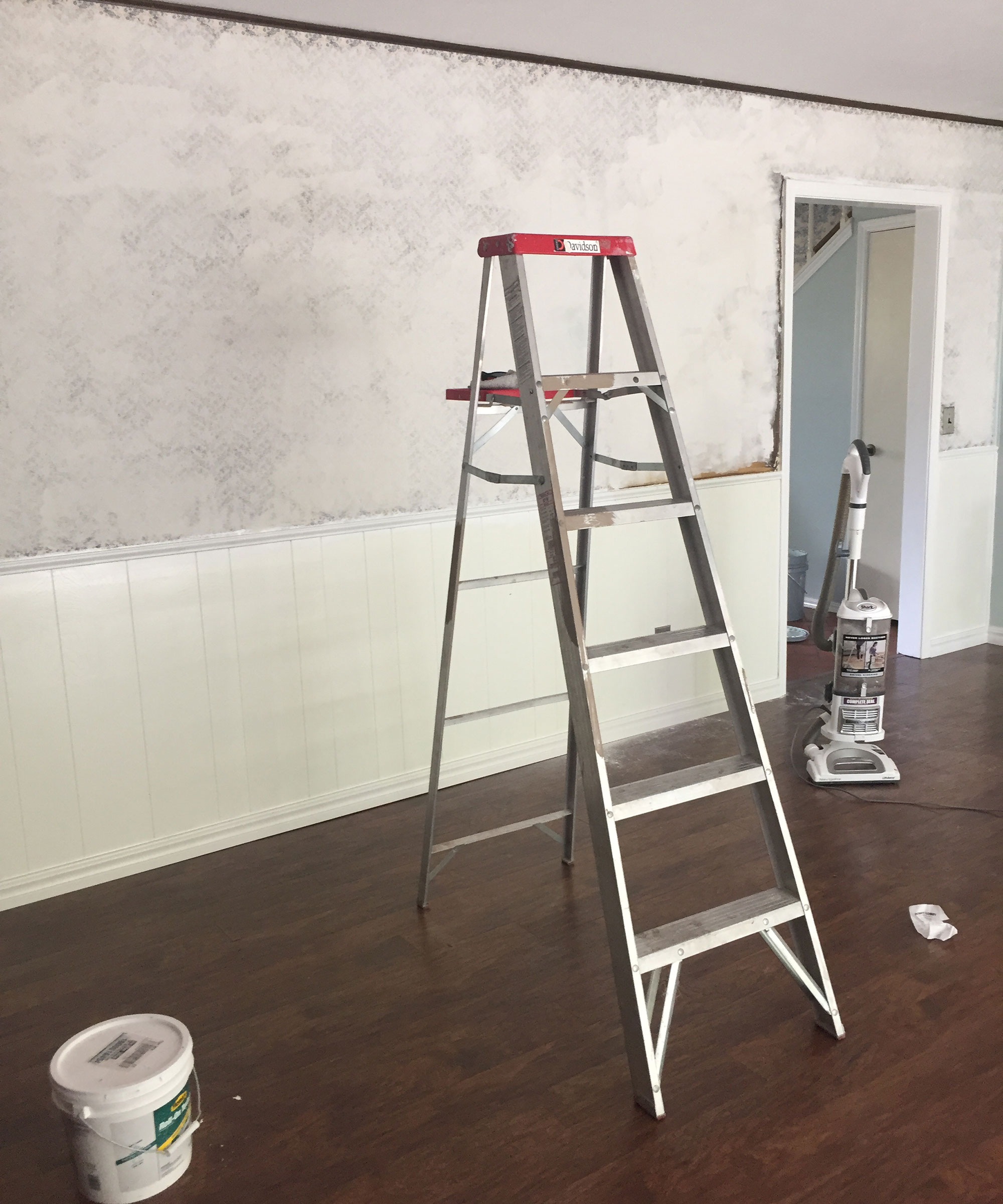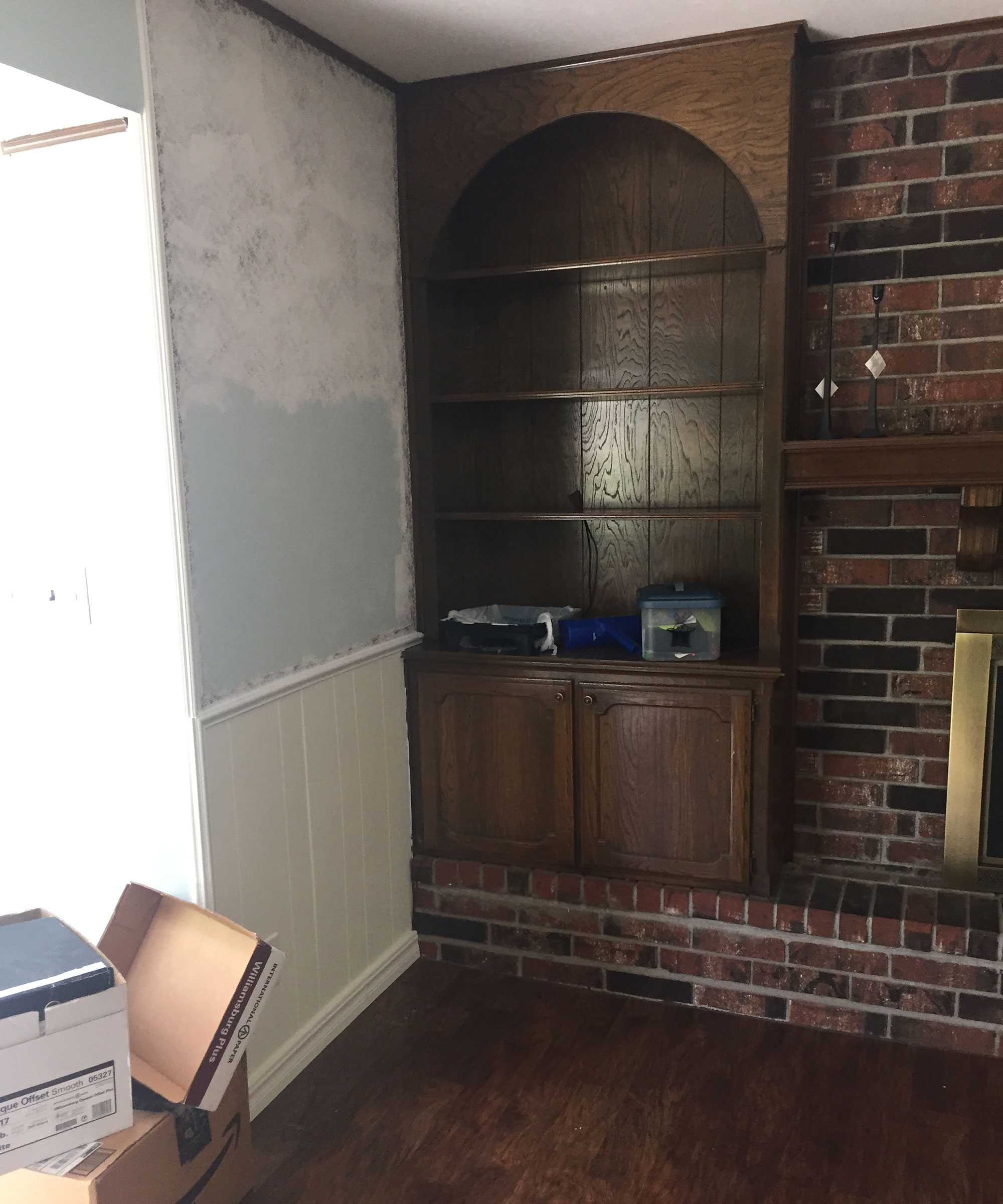How to paint over wallpaper – when it's a good idea and how to get a pro finish
Painting over wallpaper is a controversial topic in the DIY world but it can be worth it. This is how to get smooth results with tips from the experts.

Dori Turner

There are a few different reasons why you might find yourself wanting to paint over wallpaper in your home. You might have inherited an outdated wallpaper pattern and want a super quick, budget-friendly room refresh. Then you might find yourself painting over wallpaper because it's the best option, say if the original wallpaper was installed onto sheetrock and was going to cost you a ton to remove...
While most industry experts will advise you to remove wallpaper at all costs, painting over what you have is an easy DIY job that doesn't have to compromise on great results when approached in the right way. You need to prime your wall covering properly – an oil-based primer is often the best way to go – use the right tools, materials and techniques for a professional finish. To complete your 101 on how to paint over wallpaper, we’ve called in some expert decorators too for their top tips.
Guest blogger and DIY-er Dori Turner shared her experience: 'When we moved into our 1970s home it still featured the original wallpaper in most of the rooms. When we went to try to remove it, we realized it had been installed directly to the sheetrock. Any attempt to remove it would have damaged the sheetrock beyond repair. We had two options: install all new sheetrock or paint over the existing wallpaper.
Since the wallpaper covered most of the house, all new sheetrock was going to cost quite a bit. We opted to paint over the wallpaper instead. We had done this before in a previous house with great results.'
What kind of paint do you use to paint over wallpaper?
You can use the paint you prefer to paint over wallpaper, whether it’s oil-based or water-based. However, before your topcoat goes on, you’ll need to use an oil-based primer on the walls. Never use a water-based primer because it can cause the wallpaper to become loose – which is definitely what you don’t want.
Turner adds 'You can use an oil-based or latex primer and then use a latex interior paint for the topcoat.'

How to paint over wallpaper
As touched on, if you ask experts if painting over wallpaper is a good idea, they’ll probably advise you to strip it off the walls and start over instead. But it’s possible that you may uncover issues with the wall below you can’t know about if it wasn’t you who hung the wallpaper in the first place.
Get small space home decor ideas, celeb inspiration, DIY tips and more, straight to your inbox!
The other complication is that what you’re looking at might only be the top layer of wallpaper with many below, and layers of wallpaper are more challenging to remove.
The takeaway? You can remove existing wallpaper and make any necessary repairs to the wall, but if time is of the essence it’s perfectly viable to paint a wall that is wallpapered.
'You can paint directly onto wallpaper, it is recommended to prime first to give the paint a good base to adhere to and prevent the wallpaper from bubbling up underneath the paint. ' Adds Turner.
You will need:
- Protective eyewear
- Dust sheets, basic dust sheets from Amazon are fine
- Cloth
- Mild detergent or TSP for greasy walls
- Wallpaper adhesive, if required
- Painter’s tape
- Small angled brushes
- The best paint brushes or roller
- Oil-based primer
- Water or oil-based paint
1. Clean the walls
‘The first step in painting over wallpaper is to make sure the walls are completely clean,’ says Emily Perez, Head of Design at Kitchen Infinity. ‘It is necessary to ensure that there are no particles of dust or other dirty things. The priming process is hampered if the wall is not properly cleaned.’
To clean walls properly, use a cloth to remove any dust or grime. It should be barely damp as you don’t want to wet the walls.
If the walls are greasy, you could use a mild detergent solution but you may need to use a TSP solution instead. Follow the manufacturer’s instructions and make sure you wear safety gear.
Allow walls to dry thoroughly.
2. Make any wallpaper repairs
If any of the wallpaper is peeling or its seams are loose, now is the time to deal with these issues otherwise primer and paint could make the problems worse. Use wallpaper adhesive to secure them.
Turner adds, 'If the seams are pretty noticeable, you can use drywall spackling to go over the seams and smooth them out. Allow it to dry completely before lightly sanding to make it even with the wall. This way you won’t even know the seams were there.'
Likewise with loose or peeling corners, 'Glue down any corners that may be peeling and patch any holes in the wallpaper before you start painting.' Advises Turner.
‘It is best to cut any peeling or ripples off if possible followed by sanding down and filling in the wall,’ says Chris Moorhouse, Category Director for Timber, Building, Décor and Garden at Wickes.
Got textured wallpaper? Turner advises: 'If your wallpaper has a texture that is going to show through the paint and look bad, go over your wallpaper with a texturizer like Homax Roll On Wall Texture in White from Amazon, using a pattern like knockdown or orange peel. Allow it to fully dry and then use primer and two coats of paint for a beautiful finish!'
3. Mask baseboards and trim
Use painter’s tape to mask off the baseboards, window and door trims, and molding to avoid getting any primer or paint on these surfaces.
4. Prime walls
Apply primer to the walls. ‘It’s important to use an oil-based primer for this, as a water-based one won’t work,’ says Thomas Jepsen, CEO of Passion Plans. ‘A water-based primer would simply be sucked up by the wallpaper whereas the oil-based one provides that outside layer you need to be able to paint on top of.’
Start by cutting in the corners and edges using a small angled paintbrush. After that it’s easiest to use a roller, but you can apply the primer with a paintbrush if you prefer. Make sure the room is well ventilated as you work.
Leave to dry thoroughly according to the manufacturer’s instructions.

5. Apply the topcoat
When the primer is dry, you can apply the topcoat. As with the primer, use a small angled brush to cut in around doors and windows and along the baseboards. Then use a paint roller to apply the paint to the wall.
Start in a corner and paint in horizontal bands from the top of the wall to the bottom.
Allow the paint to dry completely. Check the tin for approximate drying time but remember that weather conditions can affect how long it takes.

6. Finish with a second coat of paint
For best results, and particularly if the wallpaper is dark in color or has a bold pattern, you’ll need to apply a second coat of paint. Allow to dry thoroughly.
Remember to remove the painter’s tape before the paint is cured. Check manufacturer’s recommendations, but generally it should be removed when the paint is dry to the touch, about an hour after painting. Pull it off slowly and at a 45 degree angle.

Is painting over wallpaper a good idea?
Turner notes how 'Painting over wallpaper can be a great option if the wallpaper was installed directly on the sheetrock. In this case, you would have to completely replace the sheetrock which can be costly. Painting over it instead can save time and money if done right.
Prepare wallpaper by cleaning it with a damp cloth and allowing it to dry. Prime the wallpaper and finish off with your favorite latex paint. Priming is a must to give the new coat of paint something to adhere to.'

You shouldn’t paint over wallpaper if the risk is disappointing results. ‘Painting over wallpaper that contains glitter or is a metallic design tends to be tricky as these textures will leave you with an uneven finish,’ says Jason Hines, Trading Director for Decorative, Homebase.
‘If you’re not sure whether your wallpaper can be painted over, but you’re sure you want a change, I’d always test a small, hidden patch first before committing to a whole wall.’
Bear in mind, too, that in one scenario painting over wallpaper won’t be possible. ‘If it’s fabric-backed vinyl, you’re also not able to just paint over it,’ adds Jepsen.
Old wallpaper, meanwhile, can be painted but the finish might not be great. The best strategy here again is to test in a small area making sure that the old paper doesn’t bubble up or come away from the wall.
If it’s going on smoothly, use emulsion paint – but always full strength – as a first coat and apply with a brush, or roller.
Old wallpaper that’s not suitable for painting or metallic wallpaper? Then you need to strip the wall.
Get your brushes out! Why not try one of the best Farrow & Ball paints?

Sarah is a freelance journalist and editor writing for websites, national newspapers, and magazines. She’s spent most of her journalistic career specialising in homes – long enough to see fridges become smart, decorating fashions embrace both minimalism and maximalism, and interiors that blur the indoor/outdoor link become a must-have. She loves testing the latest home appliances, revealing the trends in furnishings and fittings for every room, and investigating the benefits, costs and practicalities of home improvement. It's no big surprise that she likes to put what she writes about into practice, and is a serial house revamper. For Realhomes.com, Sarah reviews coffee machines and vacuum cleaners, taking them through their paces at home to give us an honest, real life review and comparison of every model.